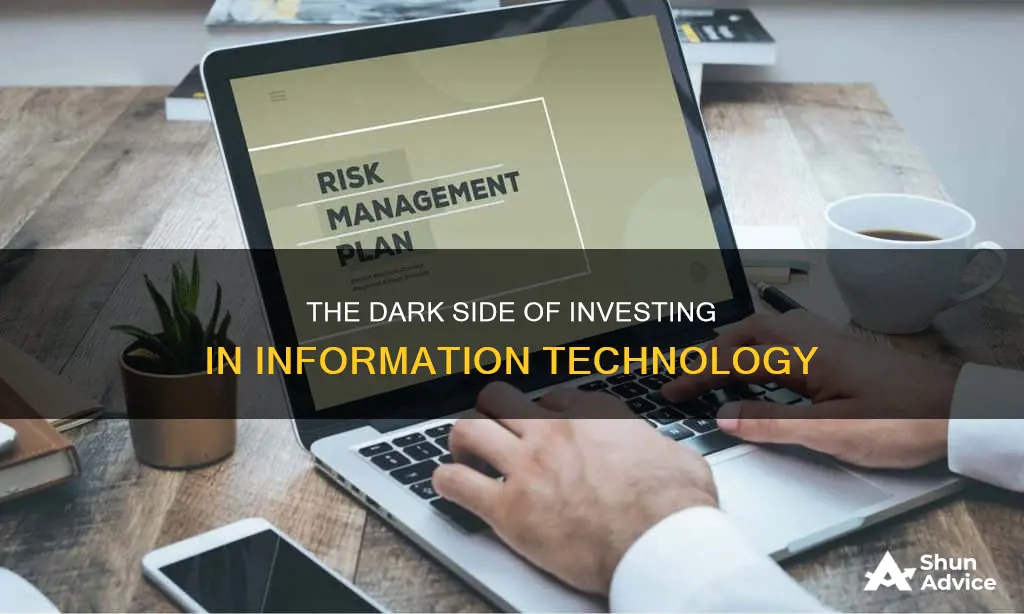
Investing in information technology can be a double-edged sword, offering immense rewards but also carrying significant risks that need careful navigation. The fast-changing nature of the tech landscape, with its constant innovation and rapid evolution, makes it a highly volatile sector. As such, investors must be vigilant about the potential pitfalls that could lead to financial losses and negative impacts on their businesses. The risks range from market conditions and regulatory compliance to cybersecurity threats and data breaches, which have become increasingly common. With the right strategies, however, these risks can be mitigated, and investors can reap the benefits of emerging technologies while minimising potential downsides.
What You'll Learn

Regulatory and Legal Risks
Compliance and Regulatory Risks
Compliance and regulatory risks are critical factors when investing in information technology. Organisations must ensure that their technology choices and implementations comply with relevant laws, regulations, and industry standards. This includes privacy and data protection regulations, financial regulations, and industry-specific requirements. Non-compliance can result in legal penalties, operational disruptions, and reputational damage. Thus, it is essential to have a robust understanding of the regulatory landscape and conduct thorough due diligence to ensure ongoing compliance.
Data Governance and Security
The protection of sensitive data is a significant regulatory and legal risk. As technology advancements increase the volume and accessibility of data, ensuring its security and proper handling becomes more challenging. Organisations must implement robust data governance practices, including encryption, access controls, and regular audits. Failure to safeguard data can result in data breaches, unauthorised access, and non-compliance with data protection regulations, leading to financial losses and reputational damage.
Technology Choice and Implementation
The choice of technology and its implementation can introduce regulatory and legal risks. Investing in immature or unproven technologies may carry higher risks, and organisations must assess the potential for recurrence, where business problems persist despite technology injections, and degradation, where existing business processes deteriorate due to technology changes. Additionally, the "wrong tech" choice may occur if the software does not align with broader strategic business processes or fails to address urgent business needs.
Insurance Coverage
Tech companies, particularly those investing in computer equipment and data management, should be aware of potential gaps in their insurance coverage. While general liability covers bodily injury and property damage, it may exclude claims related to software or programming. Similarly, traditional professional liability policies may exclude information security breaches and copyright infringement of computer code. Therefore, it is crucial to select an insurer with customised products for tech companies, ensuring comprehensive coverage for these specific risks.
Leadership Understanding
A critical aspect of mitigating regulatory and legal risks is ensuring that the board of directors and executive leadership have a comprehensive understanding of emerging technologies. This includes recognising ethical issues, such as data privacy, bias, and the misuse of AI tools, as well as potential compliance issues. A knowledge gap at the executive level can lead to inadequate risk assessment, delayed responses to technology-related risks, and increased vulnerability to threats.
In conclusion, regulatory and legal risks are multifaceted and require a proactive approach. Organisations must ensure compliance with regulations, safeguard data, make strategic technology choices, review insurance coverage, and foster a strong understanding of emerging technologies at the leadership level. By addressing these considerations, businesses can effectively manage these risks and protect their operations.
Private vs Public Equity: Where Should You Invest?
You may want to see also

Data Breaches
There are various causes of data breaches, including accidental insider threats, malicious insider threats, lost or stolen devices, and external criminal activity. Additionally, cyberattacks such as phishing, malware, and brute force attacks are common methods used by hackers to gain access to sensitive information.
To mitigate the risk of data breaches, organizations should implement robust security measures, including employee training on security best practices and data protection. Encryption of sensitive data, both at rest and in transit, is essential to protect information even if it is accessed without authorization. Strong credentials and multi-factor authentication are also crucial to encourage better cybersecurity practices among users.
Additionally, it is important to regularly update software and conduct vulnerability assessments to identify and patch any security flaws that may be exploited by attackers. Having an incident response plan in place is also crucial to minimize the impact of a data breach and restore operations as quickly as possible.
The impact of a data breach can be devastating for organizations, resulting in financial losses, disruption to operations, and damage to their reputation and customer trust. In some cases, data breaches may also result in legal consequences, fines, and even the loss of the right to operate. It is crucial for organizations to prioritize data security and implement effective measures to protect sensitive information.
Impact of Data Breaches
For organizations, data breaches can result in financial losses, disruption to operations, and damage to their reputation and customer trust. In some cases, data breaches may also result in legal consequences, fines, and even the loss of the right to operate. It is crucial for organizations to prioritize data security and implement effective measures to protect sensitive information.
Common Causes of Data Breaches
External threats, such as lost or stolen devices containing sensitive information, and malicious outside criminals who use various attack vectors to gather information, are also common causes of data breaches. It is important for organizations to have measures in place to secure devices and protect data, even in the event of loss or theft.
Cyberattacks and Data Breaches
Cyberattacks are a significant cause of data breaches. Phishing attacks, for example, are designed to deceive individuals into providing access to sensitive data or disclosing the data itself. Malware and ransomware are also commonly used to gain access to systems and data. Brute force attacks, where hackers use software tools to guess passwords, have become increasingly rapid due to improvements in computer speeds.
Mitigating the Risk of Data Breaches
To mitigate the risk of data breaches, organizations should implement robust security measures. This includes employee training on security best practices and data protection. Encryption of sensitive data, both at rest and in transit, is essential to protect information even if it is accessed without authorization. Strong credentials and multi-factor authentication are also crucial to encourage better cybersecurity practices among users.
Additionally, it is important to regularly update software and conduct vulnerability assessments to identify and patch any security flaws that may be exploited by attackers. Having an incident response plan in place is also crucial to minimize the impact of a data breach and restore operations as quickly as possible.
Investing Your Earnings: Strategies for Long-Term Wealth Creation
You may want to see also

Geopolitical and Economic Risks
Investing in information technology comes with a unique set of geopolitical and economic risks that investors should be aware of. These risks are often unpredictable and can have significant financial implications. Here are some key considerations:
Geopolitical Risks:
- International Conflicts: Geopolitical tensions and conflicts between nations can impact the stability of the market and disrupt global supply chains. For example, the ongoing Russia-Ukraine conflict has led to economic sanctions and market volatility, affecting IT companies with operations or suppliers in the region.
- Regulatory and Legal Changes: Changes in government policies and regulations can impact the IT industry. For instance, data privacy laws, such as GDPR, or trade policies can affect how companies operate and increase compliance costs.
- Economic Sanctions: Economic sanctions imposed by governments can directly impact IT companies, especially those with global operations. This may restrict their ability to do business in certain countries or with specific entities, disrupting their supply chains and limiting their market access.
- Political Uncertainty: Uncertainty surrounding political events, such as elections or policy changes, can create an unstable business environment. This can cause fluctuations in the market and impact investment decisions.
Economic Risks:
- Market Volatility: The IT industry is susceptible to market volatility, and economic downturns can affect IT spending. During economic recessions, businesses and consumers may cut back on technology purchases, impacting the revenue of IT companies.
- Competitive Landscape: The fast-paced nature of the IT industry means that new technologies and competitors can quickly emerge, rendering existing products or services obsolete. This can lead to a decline in demand and market share for established companies.
- Financial Losses: Investing in the wrong technology or failing to innovate can result in significant financial losses. Choosing software or hardware that does not align with business needs or fails to address existing problems can be costly.
- Economic Cycles: The IT industry is often influenced by economic cycles. Downturns in the economy can affect the performance of IT companies, and they may need to adjust their strategies accordingly.
To mitigate these geopolitical and economic risks, investors should stay informed about global developments, conduct thorough due diligence, and diversify their investments across different technologies, sectors, and regions. By being proactive and vigilant, investors can better navigate the complex landscape of investing in information technology.
Emergency Savings: Invest or Keep?
You may want to see also

Market Risk
The technology sector is known for its high volatility and rapid innovation cycles, which can lead to significant fluctuations in market conditions. As a result, investors in this sector face the risk of their investments losing value if they fail to adapt to changing market trends and demands.
For instance, a company that fails to integrate new technologies, such as cloud computing, artificial intelligence, or the Internet of Things, into their existing business strategies may experience decreased returns on their investments. This could be due to reduced productivity, increased costs, or a failure to meet customer expectations.
Additionally, market risk in the technology sector can be influenced by various factors, including the pace of innovation, safety considerations, and limited awareness among users and stakeholders. The rapid development of new technologies may outpace the establishment of risk assessment and regulatory frameworks, potentially leaving gaps in risk management. A strong emphasis on innovation can also overshadow potential risks, leading to a culture where safety concerns are neglected in favour of introducing new features and capabilities.
Furthermore, market risk in the technology sector is often influenced by strategic alignment, or the lack thereof. When emerging technologies are not aligned with a company's strategic goals and existing business processes, it can result in poor returns on investment and low stakeholder buy-in. For example, a manufacturing company that adopts IoT sensors to monitor equipment performance without integrating them effectively into their maintenance strategies may face unplanned downtime, higher costs, and reduced productivity.
To mitigate market risk, it is crucial for investors and businesses to stay informed about emerging technologies, industry trends, and market demands. Conducting thorough research, seeking expert consultation, and diversifying investments across various technologies and sectors can help minimize the impact of changing market conditions. Additionally, businesses should ensure that their technology investments support their strategic vision and are properly integrated into their existing operations to maximize returns and reduce market risk.
Understanding Managed Portfolio Investment Strategies and Benefits
You may want to see also

Cybersecurity Risk
The exponential growth of information technology reliance has transformed the global economy and disrupted industries, but it has also exposed firms to cyber threats, which have become a significant and rapidly evolving source of risk. Cyberattacks can result in the illegal appropriation of trade secrets, such as blueprints and formulas, as well as the theft of non-patentable information like social security numbers and customer data. This has severe consequences, with industrial cyber thefts costing American corporations an estimated $360 billion annually.
To mitigate these risks, businesses must adopt a proactive approach, addressing both technical and human aspects of cybersecurity. This includes implementing robust cybersecurity solutions, such as software upgrades, hardware enhancements, and infrastructure improvements. Additionally, businesses should focus on training and educating employees about data security, as human error or negligence can often lead to data breaches.
Furthermore, it is essential to assess the potential savings from avoiding data breaches. By investing in cybersecurity measures, businesses can reduce the likelihood of data breaches and minimise financial losses. This involves assessing the probability of an attack and its potential impact on operations and assets.
To optimise their cybersecurity investment, businesses can also leverage cost-effective solutions like a Document Management System (DMS). A DMS provides a centralised platform for secure document storage, management, and control, enhancing data security and compliance with regulations.
By understanding the complex nature of cybersecurity risks, businesses can make informed decisions, allocate resources effectively, and safeguard their operations, assets, and reputation in the digital landscape.
Investing in Apollo Global Management: A Comprehensive Guide
You may want to see also







